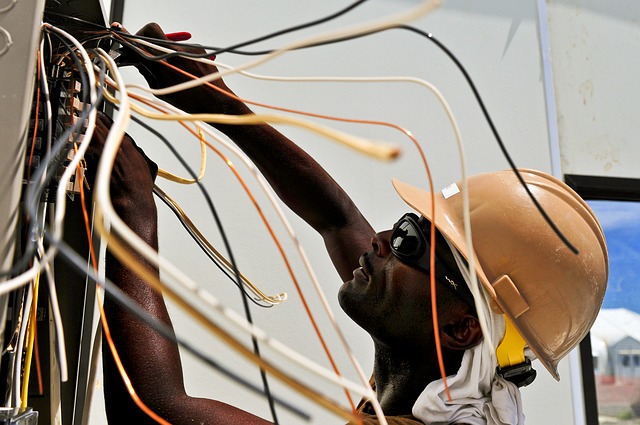Tailored BRE Electrical Solutions for Homes and Businesses
Tailored BRE Electrical Solutions for Homes and Businesses
Blog Article
The Ultimate Overview to Electric Installment: Tips and Techniques for a Safe and Effective Home Wiring System
In the world of home maintenance, few aspects are as important yet commonly neglected as the electrical wiring system. By discovering the subtleties of electric security steps and energy-saving practices, this extensive guide will certainly drop light on the ins and outs of home electrical wiring, empowering people to take cost of their family's electrical infrastructure.
Recognizing Electric Security Measures
To make certain the safety and security of both individuals and building, understanding and carrying out appropriate electrical precaution is paramount in any kind of home electrical wiring project. Electricity is an effective force that can be hazardous otherwise managed with care. One of the basic security steps is ensuring that all electric work is executed by qualified professionals that follow local building regulations and policies. It is crucial to perform a complete evaluation of the electric system before beginning any electrical wiring project to determine potential threats or problems that require to be addressed.
In addition, using the suitable tools and devices is essential for maintaining security during electric installments. Insulated gloves, voltage testers, and protective eyewear are some of the basic security gear that must be used to avoid electric shocks or crashes. It is additionally vital to de-energize circuits prior to servicing them and to classify all circuits and breakers plainly to stay clear of complication.
.jpeg)
Important Tools for Home Circuitry
Ensuring the proper application of electrical security procedures in home circuitry tasks entails utilizing a specific set of important tools developed to help with the setup process efficiently and safely. Some of the secret tools required for home wiring projects include a voltage tester for examining real-time cords, cord pole dancers for eliminating insulation from cords, a cable cutter for exactly cutting wires to length, a screwdriver established for securing electrical components, electric tape for insulation and safeguarding links, a cable television ripper for stripping cable sheathing, and a multimeter for measuring voltage, existing, and resistance.
Step-by-Step Electric Setup Guide
Starting an electric setup project requires thorough preparation and adherence to security guidelines. Prior to starting any job, guarantee you have an in-depth plan outlining the format of the electric system, including the placement of electrical outlets, switches, and fixtures. Take into consideration the power demands of each device to establish the proper wire scale and circuit breaker dimensions.
The initial step in the installment process is to shut down the power supply to the location where you will be functioning. Use a voltage tester to validate that the circuits are de-energized before touching any kind of cables. Next off, very carefully remove existing components or outlets and separate the wires.
When mounting new electrical wiring, run wires through walls and ceilings, safeguarding them in position with proper installations. Follow regional structure codes and manufacturer directions for correct cord installation and connections. BRE Services. See to it to identify cords for easy identification and future maintenance

Troubleshooting Common Electrical Wiring Issues
Having completed the installment procedure as detailed in the previous subtopic, fixing common circuitry concerns is a crucial ability for making sure the security and performance of your electrical system. One common concern is a stumbled circuit breaker, typically brought on by overloaded circuits or a short circuit. To repair this, find the breaker panel, identify the stumbled breaker by seeking the one not completely in the "on" position, and reset it by turning it totally to "off" and then back to "on." Another widespread issue is a defective electrical outlet, defined by no power or intermittent power supply. Make certain the outlet is not controlled by a button, then make use of a voltage tester to look for power. If there is no power, turn off the circuit, inspect the wiring links for any loose or broken wires, and change the outlet if needed. Continuously flickering lights can suggest loosened wiring links or an overloaded circuit. To address this, check and tighten all cord connections in the influenced fixtures and buttons and rearrange the tons on the circuit to stabilize the electrical demand. Routinely checking and promptly attending to these typical wiring problems will certainly maintain the security and efficiency of your home electrical system.
Tips for Energy-Efficient Electrical Systems
For optimal energy efficiency in electric systems, implementing clever techniques and making use of energy-saving modern technologies is extremely important. One vital pointer for attaining an energy-efficient electric system is to upgrade to LED illumination. LED bulbs consume considerably less power than typical incandescent light bulbs and have a longer life-span, making them a cost-effective selection in the future. Furthermore, setting up programmable thermostats can help regulate home heating and cooling down systems, decreasing energy waste when no person is home. An additional method is to invest in energy-efficient appliances that are power celebrity accredited, ensuring they fulfill high requirements for energy performance. Appropriate insulation and sealing of windows, doors, and electrical outlets can likewise avoid energy loss, ultimately lowering the work on electric systems. Consider including renewable energy resources like solar panels to more decline dependence on conventional power grids. By including these energy-efficient pointers and innovations, home owners can not only conserve cash on their power costs yet likewise reduce their ecological influence.
Final Thought
In final thought, implementing correct safety procedures, utilizing vital devices, following a step-by-step installation guide, troubleshooting typical concerns, and incorporating energy-efficient tips are critical for a risk-free and efficient home electrical wiring system. By sticking to these practices, property owners can guarantee the longevity and performance of their electrical installments. It is very important to focus on safety and security and effectiveness when it comes to electrical operate in order to avoid BRE Automation Australia potential hazards and to preserve a reputable electric system in the home.
Report this page